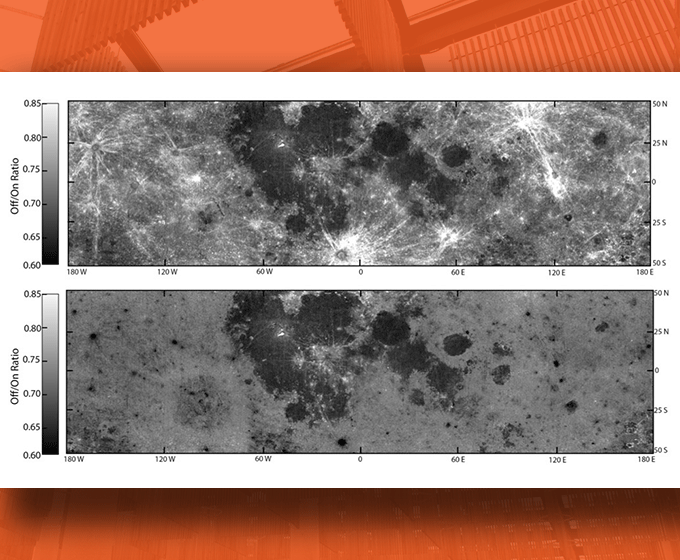
A new study by a recent graduate of SwRI’s joint graduate program in physics with UTSA shows that the Lyman-Alpha Mapping Project, a SwRI-created mapping instrument aboard NASA’s Lunar Reconnaissance Orbiter, can determine the composition of areas on the lunar surface by measuring the reflectance of far-ultraviolet light. The top image shows younger, less mature features such as impact craters and rays while the bottom image shows these features removed by the study’s newly reported methods, providing compositionally distinct features for subsequent analysis. Courtesy: NASA/SwRI
OCTOBER 8, 2021 — A new study by a recent graduate of Southwest Research Institute’s joint graduate program in physics with The University of Texas at San Antonio demonstrates the ability of the Lyman-Alpha Mapping Project (LAMP) to determine the composition of areas on the lunar surface by measuring the reflectance of far-ultraviolet (far-UV) light.
LAMP is a SwRI-created, far-UV spectrograph instrument aboard NASA’s Lunar Reconnaissance Orbiter (LRO), a robotic mission launched in 2009 to study the surface of the Moon and investigate possible future landing sites. The instrument’s primary purpose is to find ice water in deep polar craters using ultraviolet light generated by stars as well as the hydrogen atoms that are thinly spread throughout the solar system.
LAMP is also able to measure the maturity, or age, of the surface, based on the degree of space weathering that the lunar surface has undergone with time. Less mature locations, such as fresh impact craters, have been found to be more reflective in the visible and certain regions of the far-UV spectrum.
“We’re using the optical maturity parameter to normalize these younger, less mature features in our maps of the lunar surface,” said the study’s lead author, Benjamin Byron, a postdoctoral researcher at NASA’s Jet Propulsion Laboratory who conducted the research during the SwRI-UTSA graduate program. “This method had previously been used for other regions of the spectrum, but we’ve shown for the first time that it can be used for the far-UV as well.”
Previous instruments have characterized this surface maturity at visible wavelengths using an index called the optical maturity parameter. Byron utilized this knowledge to similarly remove maturity-related features from far-UV maps of the lunar surface so that only data about the surface’s composition remained.
“What we see in our far-UV maps is a close correlation with composition maps from other regions of the electromagnetic spectrum,” Byron said. “We’re seeing these composition-related trends stand out in our maps more clearly than they had before, which allows us to have a global view of composition in the far-UV. It just goes to show that far-UV instruments such as LAMP are useful in performing compositional mapping for the Moon and for other bodies as well.”
While far-UV spectrographs have been used to study the atmosphere and exosphere of other planetary bodies before, LAMP is the first to measure the composition of the lunar surface using surface-reflected light in these wavelengths.
“I think this work shows how important it is to include instruments like these on future missions,” Byron said.
He believes the next step is to use this method to study the composition of specific lunar features more deeply and plans to pursue that work with SwRI staff and current members of the SwRI-UTSA graduate program.
Byron’s study, “Lunar Surface Composition Constraints from Maturity-corrected Far-ultraviolet Reflectance Maps,” will appear in the October issue of The Planetary Science Journal.
The SwRI-UTSA graduate program where Byron began this research prepares graduate students for a career in space physics and gives them hands-on research experience in space instrumentation. UTSA is one of the largest schools in the University of Texas system and has been ranked one of the top 100 universities in the world under 50 years old by the Times Higher Education.
UTSA Today is produced by University Communications and Marketing, the official news source of The University of Texas at San Antonio. Send your feedback to news@utsa.edu. Keep up-to-date on UTSA news by visiting UTSA Today. Connect with UTSA online at Facebook, Twitter, Youtube and Instagram.
Move In To COLFA is strongly recommended for new students in COLFA. It gives you the chance to learn about the Student Success Center, campus resources and meet new friends!
Academic Classroom: Lecture Hall (MH 2.01.10,) McKinney Humanities BldgWe invite you to join us for Birds Up! Downtown, an exciting welcome back event designed to connect students with the different departments at the Downtown Campus. Students will have the opportunity to learn about some of the departments on campus, gain access to different resources, and collect some giveaways!
Bill Miller PlazaCome and celebrate this year's homecoming at the Downtown Campus with food, games, giveaways, music, and more. We look forward to seeing your Roadrunner Spirit!
Bill Miller PlazaThe University of Texas at San Antonio is dedicated to the advancement of knowledge through research and discovery, teaching and learning, community engagement and public service. As an institution of access and excellence, UTSA embraces multicultural traditions and serves as a center for intellectual and creative resources as well as a catalyst for socioeconomic development and the commercialization of intellectual property - for Texas, the nation and the world.
To be a premier public research university, providing access to educational excellence and preparing citizen leaders for the global environment.
We encourage an environment of dialogue and discovery, where integrity, excellence, respect, collaboration and innovation are fostered.